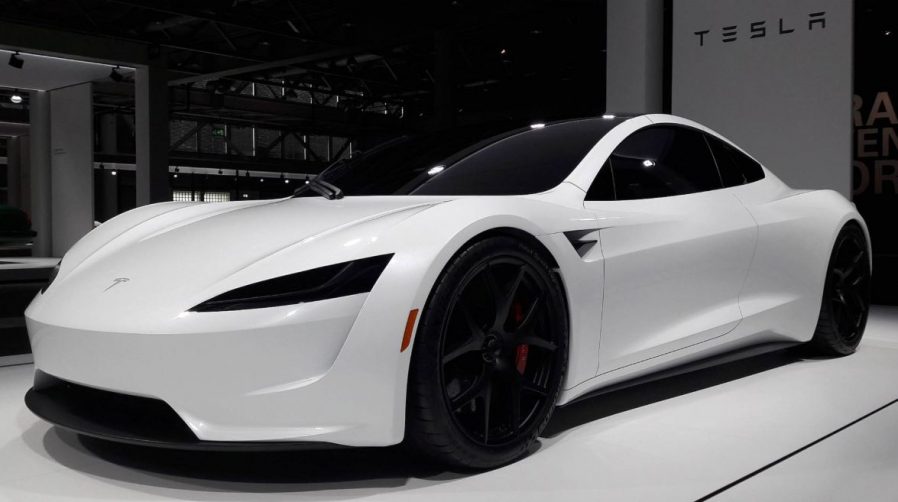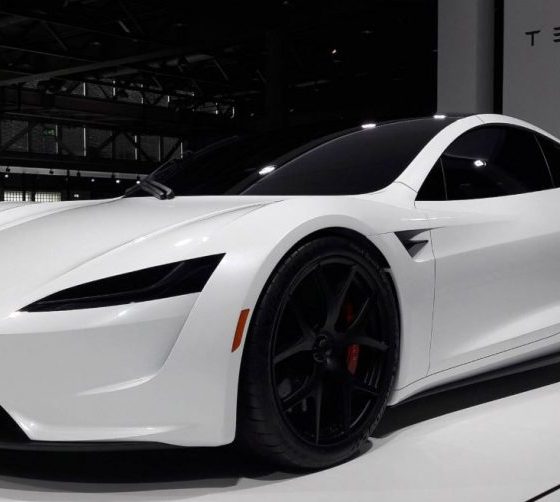

News
Tesla’s Bitcoin investment has been a rollercoaster ride of gains and losses
One of the ultimate joyrides as a human is riding a rollercoaster. The anticipation of sitting in the train, waiting for dispatch as you slowly climb up the first gigantic hill, all for the anticipation to break. Suddenly, you’re falling down a 200+ foot drop, awaiting the next rise, which will unequivocally result in another slight drop. A short time later, you’re right back to where you started, in a pavilion, waiting to get off of the ride.
Tesla’s Bitcoin investment has been a comparable scenario described above: a meteoric climb, succeeded by a sharp drop, followed by tiny peaks and valleys. Ultimately, Tesla is right back to where it started.
In the company’s 10-Q filing with the SEC earlier today, the electric car company based out of Northern California detailed its tumultuous experience with Bitcoin, the cryptocurrency that could likely be attributed to most of the ranting and raving regarding digital assets. It allowed anyone who can access the document a peek into what kind of swings Tesla has been experiencing through its investment into Bitcoin, which was detailed in the 10-K filing after Q4 2020 results.
Climbing up the first hill
Tesla’s $1.5 billion investment started in the gate and quickly took off up the first hill of gains like a launch rollercoaster. The first hill lasted quite some time, as Bitcoin eclipsed $64,000 and put Tesla up a substantial sum. It is not known how many BTC Tesla received when it initially invested the $1.5 billion, but it is estimated that the price of the crypto was between $29,333 and $37,020. This would put Tesla’s potential holdings at between 37,020 to 51,137 BTC.
It was estimated that Tesla made close to or more than $1 billion as Bitcoin continued to rise in value through the early portion of 2021. According to an April report from Teslarati, “Even if Tesla only acquired the minimal amount of 37,020 Bitcoin in January, the company’s $1.5 billion investment would still be worth $2.3 billion today, hinting at a healthy profit of $800 million,” and that’s figure originates from the possibility of their lowest BTC investment. Tesla said it realized gains of $128 million from its digital assets in March 2021 alone.
After reaching all-time highs of over $64,829, Bitcoin started to tumble, bringing Tesla’s rollercoaster ride down its first and largest hill.
The Big Drop
The big drop occurred as Bitcoin began to slide in mid-May. From May 8th to the 22nd, Bitcoin slid from $58,788 to under $37,500. At one point, BTC even struck the $30,000 range before recovering to $38,000.
The slide was met with uncertainty, worry, and anxiety by many investors. But Musk solidified the fact that Tesla would keep its “diamond hands” and continue holding BTC, despite the volatility experienced during its epic fall.
The company wrote:
“During the three and six months ended June 30, 2021, we recorded $23 million and $50 million, respectively, of impairment losses on such digital assets.”
The Ride: Back to the Beginning
Through the tumultuous ride of the BTC rollercoaster through the first half of 2021, Tesla rode the hills, the turns, and loops and ended up right back where it started (basically). As of June 30, Tesla says the fair market value of such digital assets “was $1.47 billion.” Additionally, the company said that “as of June 30, 2021, the carrying value of our digital assets held was $1.31 billion, which reflects cumulative impairments of $50 million.”
It has been exciting, and it has been uncertain, but Tesla, like the rest of investors, is just along for the ride. Bitcoin’s volatility over the past few months may not have been expected by the diehard cryptocurrency supporters that have vocally supported it since its early days. Still, like anything else, it is an investment. Tesla is banking on a wider adoption of crypto in the coming months and years, something it has dabbled with in the past.

Elon Musk
Elon Musk’s X will start using a Tesla-like software update strategy
The initiative seems designed to accelerate updates to the social media platform, while maintaining maximum transparency.

Elon Musk’s social media platform X will adopt a Tesla-esque approach to software updates for its algorithm.
The initiative seems designed to accelerate updates to the social media platform, while maintaining maximum transparency.
X’s updates to its updates
As per Musk in a post on X, the social media company will be making a new algorithm to determine what organic and advertising posts are recommended to users. These updates would then be repeated every four weeks.
“We will make the new 𝕏 algorithm, including all code used to determine what organic and advertising posts are recommended to users, open source in 7 days. This will be repeated every 4 weeks, with comprehensive developer notes, to help you understand what changed,” Musk wrote in his post.
The initiative somewhat mirrors Tesla’s over-the-air update model, where vehicle software is regularly refined and pushed to users with detailed release notes. This should allow users to better understand the details of X’s every update and foster a healthy feedback loop for the social media platform.
xAI and X
X, formerly Twitter, has been acquired by Elon Musk’s artificial intelligence startup, xAI last year. Since then, xAI has seen a rapid rise in valuation. Following the company’s the company’s upsized $20 billion Series E funding round, estimates now suggest that xAI is worth tens about $230 to $235 billion. That’s several times larger than Tesla when Elon Musk received his controversial 2018 CEO Performance Award.
As per xAI, the Series E funding round attracted a diverse group of investors, including Valor Equity Partners, Stepstone Group, Fidelity Management & Research Company, Qatar Investment Authority, MGX, and Baron Capital Group, among others. Strategic partners NVIDIA and Cisco Investments also continued support for building the world’s largest GPU clusters.
News
Tesla FSD Supervised wins MotorTrend’s Best Driver Assistance Award
The decision marks a notable reversal for the publication from prior years, with judges citing major real-world improvements that pushed Tesla’s latest FSD software ahead of every competing ADAS system.

Tesla’s Full Self-Driving (Supervised) system has been named the best driver-assistance technology on the market, earning top honors at the 2026 MotorTrend Best Tech Awards.
The decision marks a notable reversal for the publication from prior years, with judges citing major real-world improvements that pushed Tesla’s latest FSD software ahead of every competing ADAS system. And it wasn’t even close.
MotorTrend reverses course
MotorTrend awarded Tesla FSD (Supervised) its 2026 Best Tech Driver Assistance title after extensive testing of the latest v14 software. The publication acknowledged that it had previously criticized earlier versions of FSD for erratic behavior and near-miss incidents, ultimately favoring rivals such as GM’s Super Cruise in earlier evaluations.
According to MotorTrend, the newest iteration of FSD resolved many of those shortcomings. Testers said v14 showed far smoother behavior in complex urban scenarios, including unprotected left turns, traffic circles, emergency vehicles, and dense city streets. While the system still requires constant driver supervision, judges concluded that no other advanced driver-assistance system currently matches its breadth of capability.
Unlike rival systems that rely on combinations of cameras, radar, lidar, and mapped highways, Tesla’s FSD operates using a camera-only approach and is capable of driving on city streets, rural roads, and freeways. MotorTrend stated that pure utility, the ability to handle nearly all road types, ultimately separated FSD from competitors like Ford BlueCruise, GM Super Cruise, and BMW’s Highway Assistant.
High cost and high capability
MotorTrend also addressed FSD’s pricing, which remains significantly higher than rival systems. Tesla currently charges $8,000 for a one-time purchase or $99 per month for a subscription, compared with far lower upfront and subscription costs from other automakers. The publication noted that the premium is justified given FSD’s unmatched scope and continuous software evolution.
Safety remained a central focus of the evaluation. While testers reported collision-free operation over thousands of miles, they noted ongoing concerns around FSD’s configurable driving modes, including options that allow aggressive driving and speeds beyond posted limits. MotorTrend emphasized that, like all Level 2 systems, FSD still depends on a fully attentive human driver at all times.
Despite those caveats, the publication concluded that Tesla’s rapid software progress fundamentally reshaped the competitive landscape. For drivers seeking the most capable hands-on driver-assistance system available today, MotorTrend concluded Tesla FSD (Supervised) now stands alone at the top.
News
Elon Musk’s Grokipedia surges to 5.6M articles, almost 79% of English Wikipedia
The explosive growth marks a major milestone for the AI-powered online encyclopedia, which was launched by Elon Musk’s xAI just months ago.

Elon Musk’s Grokipedia has grown to an impressive 5,615,201 articles as of today, closing in on 79% of the English Wikipedia’s current total of 7,119,376 articles.
The explosive growth marks a major milestone for the AI-powered online encyclopedia, which was launched by Elon Musk’s xAI just months ago. Needless to say, it would only be a matter of time before Grokipedia exceeds English Wikipedia in sheer volume.
Grokipedia’s rapid growth
xAI’s vision for Grokipedia emphasizes neutrality, while Grok’s reasoning capabilities allow for fast drafting and fact-checking. When Elon Musk announced the initiative in late September 2025, he noted that Grokipedia would be an improvement to Wikipedia because it would be designed to avoid bias.
At the time, Musk noted that Grokipedia “is a necessary step towards the xAI goal of understanding the Universe.”
Grokipedia was launched in late October, and while xAI was careful to list it only as Version 0.1 at the time, the online encyclopedia immediately earned praise. Wikipedia co-founder Larry Sanger highlighted the project’s innovative approach, noting how it leverages AI to fill knowledge gaps and enable rapid updates. Netizens also observed how Grokipedia tends to present articles in a more objective manner compared to Wikipedia, which is edited by humans.
Elon Musk’s ambitious plans
With 5,615,201 total articles, Grokipedia has now grown to almost 79% of English Wikipedia’s article base. This is incredibly quick, though Grokipedia remains text-only for now. xAI, for its part, has now updated the online encyclopedia’s iteration to v0.2.
Elon Musk has shared bold ideas for Grokipedia, including sending a record of the entire knowledge base to space as part of xAI’s mission to preserve and expand human understanding. At some point, Musk stated that Grokipedia will be renamed to Encyclopedia Galactica, and it will be sent to the cosmos.
“When Grokipedia is good enough (long way to go), we will change the name to Encyclopedia Galactica. It will be an open source distillation of all knowledge, including audio, images and video. Join xAI to help build the sci-fi version of the Library of Alexandria!” Musk wrote, adding in a later post that “Copies will be etched in stone and sent to the Moon, Mars and beyond. This time, it will not be lost.”








